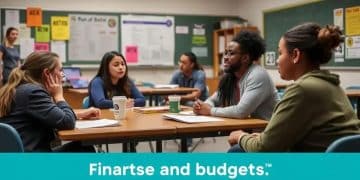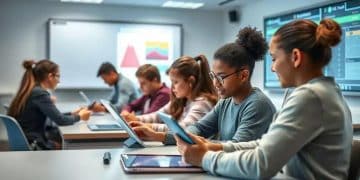Digital literacy education in underserved communities

Digital literacy education in underserved communities is vital for empowering individuals, providing essential skills that enhance employment opportunities and access to resources, ultimately transforming lives and fostering community growth.
Digital literacy education in underserved communities is more important than ever. With technology at the forefront of our daily lives, bridging the digital divide can empower individuals and create opportunities. Have you considered how digital skills can unlock potential?
Understanding digital literacy and its impact
Understanding digital literacy is crucial in our technology-driven world. It refers to the ability to access, understand, and use digital information effectively. In underserved communities, this skill can significantly impact individuals’ lives.
Digital literacy helps people navigate the internet, use computers, and communicate online. As technology evolves, so does the need for these essential skills. Many face challenges in learning because of limited access to digital tools and resources.
The Importance of Digital Literacy
In today’s economy, having strong digital skills opens doors to numerous opportunities. For instance, job applications and interviews often require online interactions. Digital literacy can also help individuals access educational resources, enhancing their knowledge and skills.
Challenges Faced in Underserved Communities
Despite the benefits, several barriers hinder the growth of digital literacy:
- Lack of access to reliable internet connections.
- Limited availability of devices such as computers or tablets.
- Insufficient training programs to help individuals learn digital skills.
- Language barriers that can complicate understanding technology.
Efforts to improve digital literacy address these issues head-on. Various programs focus on providing resources and training needed to empower individuals. These initiatives not only enhance personal skills but also improve overall community engagement.
By bridging the digital divide, individuals can become more involved in their communities. They can find better job opportunities, access vital services, and contribute to local growth. Understanding and promoting digital literacy is essential for fostering a more equitable society.
Barriers to access in underserved communities
Barriers to access in underserved communities are significant challenges that limit the growth of digital literacy. Many individuals face a lack of resources and support, making it hard to gain essential digital skills. Access to technology is often unevenly distributed, leaving some without the tools they need.
One major barrier is the digital divide. This divide creates a situation where wealthier communities have easier access to technology while underserved areas struggle. Without reliable internet, learning becomes a challenge. It is difficult to improve skills when the resources to do so are unavailable.
Common Barriers Faced
There are various factors that contribute to these barriers:
- Cost of devices: Many families cannot afford computers or tablets, putting digital tools out of reach.
- Internet accessibility: In many areas, high-speed internet is limited or unavailable, making online learning impossible.
- Lack of training programs: Without local programs to teach digital skills, many do not know where to begin.
- Language differences: Resources may not be available in the languages spoken in these communities, further complicating access.
Another challenge involves outdated materials. Even if resources are available, they may not be up-to-date, leading to misinformation. This situation can make learners feel frustrated and disconnected. Community engagement is necessary to address these challenges effectively.
Furthermore, some individuals may feel intimidated by technology. This fear can prevent them from seeking help or using resources available to them. To tackle this, supportive environments should be created, where individuals feel comfortable asking questions and practicing their skills.
Effective strategies for teaching digital skills

Effective strategies for teaching digital skills can make all the difference in underserved communities. These strategies focus on engaging learners and making technology accessible to everyone. By utilizing interactive methods, instructors can help students gain confidence in their abilities.
One effective approach is hands-on learning. When students can practice using devices and programs, they become more comfortable navigating technology. This method encourages exploration and discovery, helping learners understand digital tools in real-life contexts.
Engaging Teaching Techniques
Incorporating various teaching techniques can also enhance learning:
- Collaborative projects: Pair learners together to work on tasks, promoting teamwork while learning essential skills.
- Gamification: Use games to teach concepts, making learning fun and engaging.
- Real-world applications: Show how digital skills apply to everyday tasks, from job searching to online shopping.
Providing mentorship opportunities is another effective strategy. Experienced individuals can guide learners, offering support and encouragement as they tackle new technology. By fostering a supportive environment, students feel more motivated to improve their digital skills.
Continuously assessing progress is essential to ensure learners are developing their abilities. Creating simple assessments can help instructors identify areas where learners may need more help. Regular feedback allows students to understand their strengths and areas for improvement.
Finally, leveraging community resources can enhance programs. Partnering with local libraries, schools, or nonprofits can bring additional tools and expertise. By working together, communities can create more comprehensive training opportunities that meet the specific needs of their residents.
The role of technology in education equity
The role of technology in fostering education equity is profound. Technology has the potential to bridge gaps in learning, especially for individuals in underserved communities. When used effectively, it can provide access to resources and opportunities that were previously out of reach.
One way technology promotes educational equity is through online learning platforms. These platforms offer courses and materials from top educators worldwide, breaking geographical barriers. Students can learn at their own pace and access a variety of subjects that cater to their interests and needs.
Access to Resources
Furthermore, technology expands access to vital educational resources:
- Digital libraries: Free online libraries can provide a wealth of information and learning materials.
- Webinars and online workshops: These allow learners to participate in training sessions and gain skills that enhance their employability.
- Tutoring apps: Students can connect with tutors who provide personalized support in various subjects.
By integrating technology into education, schools can also create inclusive environments. Tools like assistive technology help learners with disabilities access the curriculum more effectively. This not only fosters a sense of belonging but also empowers every student to succeed regardless of their background.
Moreover, technology encourages collaboration. Students can work together on projects using online tools, developing teamwork and communication skills. They can share ideas and learn from each other, creating a richer educational experience.
Despite its potential, it’s essential to acknowledge that technology alone cannot solve the problems of education equity. Continuous investment in infrastructure is necessary to ensure that all students have the tools they need. Training for educators is also vital, enabling them to effectively integrate technology into their teaching.
Success stories: Transforming lives through digital literacy
Success stories of individuals transforming their lives through digital literacy showcase the real impact of education in underserved communities. These stories highlight how gaining digital skills can open doors to new opportunities and improve quality of life. Whether it’s securing a job or accessing educational resources, the benefits of digital literacy are profound.
One inspiring example is Maria, a single mother who struggled to find stable employment. After participating in a local digital literacy program, she learned how to create a resume and apply for jobs online. With her new skills, Maria secured a job that supports her family, demonstrating the power of technology in creating a brighter future.
Community-Based Initiatives
Community centers and nonprofits often play a crucial role in these transformations:
- Workshops: Many organizations offer workshops that teach essential digital skills, such as using computers and navigating the internet.
- Mentorship programs: Pairing learners with mentors helps provide support and guidance, enhancing the learning experience.
- Access to resources: Providing access to computers and high-speed internet is vital for those looking to enhance their skills.
Another example is the story of James, a young man who utilized digital literacy to start his own small business. After learning how to market his products online, James expanded his customer base beyond his local community. His story inspires others to see the benefits of digital skills in entrepreneurship.
These success stories reveal how digital literacy can lead to empowerment and independence. By sharing these experiences, communities can inspire others to take advantage of available resources. When individuals see others succeed through digital education, they are more likely to participate in similar programs.
Ultimately, the goal is to create an environment where everyone has the opportunity to learn and grow. Success stories highlight the potential within communities and serve as powerful reminders of what can be achieved through dedication and access to digital skills training.
FAQ – Frequently Asked Questions about Digital Literacy Education in Underserved Communities
What is digital literacy?
Digital literacy is the ability to safely and effectively use technology to access, manage, and create information.
How can digital literacy programs benefit underserved communities?
These programs provide essential skills that can lead to better job opportunities, educational resources, and community engagement.
What are some examples of success stories in digital literacy?
Success stories include individuals like Maria, who found stable employment, and James, who started his business through digital skills.
How can I get involved in promoting digital literacy in my community?
You can volunteer at local programs, donate resources, or advocate for digital skills training initiatives.





